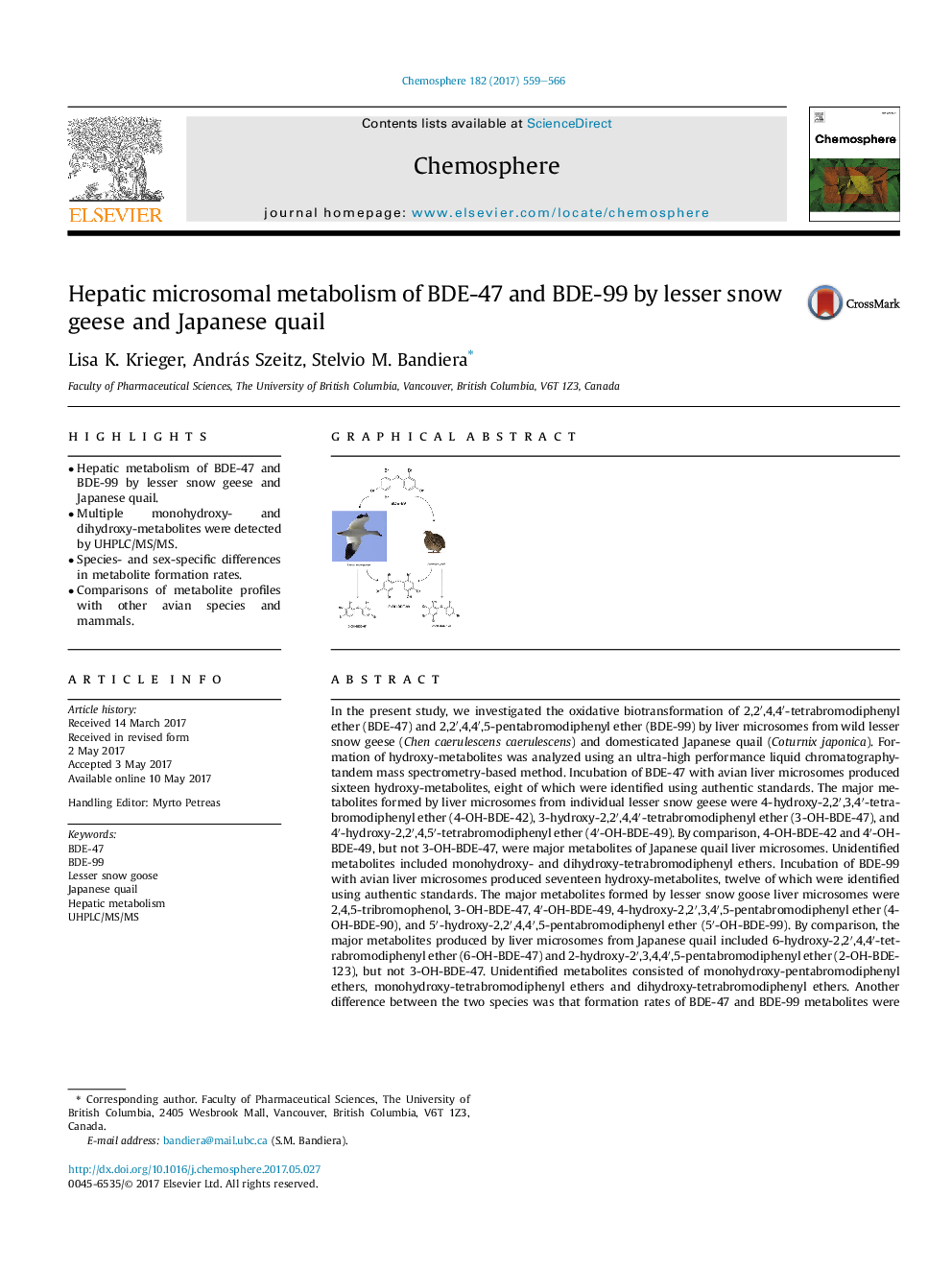| Article ID | Journal | Published Year | Pages | File Type |
|---|---|---|---|---|
| 5746893 | Chemosphere | 2017 | 8 Pages |
â¢Hepatic metabolism of BDE-47 and BDE-99 by lesser snow geese and Japanese quail.â¢Multiple monohydroxy- and dihydroxy-metabolites were detected by UHPLC/MS/MS.â¢Species- and sex-specific differences in metabolite formation rates.â¢Comparisons of metabolite profiles with other avian species and mammals.
In the present study, we investigated the oxidative biotransformation of 2,2â²,4,4â²-tetrabromodiphenyl ether (BDE-47) and 2,2â²,4,4â²,5-pentabromodiphenyl ether (BDE-99) by liver microsomes from wild lesser snow geese (Chen caerulescens caerulescens) and domesticated Japanese quail (Coturnix japonica). Formation of hydroxy-metabolites was analyzed using an ultra-high performance liquid chromatography-tandem mass spectrometry-based method. Incubation of BDE-47 with avian liver microsomes produced sixteen hydroxy-metabolites, eight of which were identified using authentic standards. The major metabolites formed by liver microsomes from individual lesser snow geese were 4-hydroxy-2,2â²,3,4â²-tetrabromodiphenyl ether (4-OH-BDE-42), 3-hydroxy-2,2â²,4,4â²-tetrabromodiphenyl ether (3-OH-BDE-47), and 4â²-hydroxy-2,2â²,4,5â²-tetrabromodiphenyl ether (4â²-OH-BDE-49). By comparison, 4-OH-BDE-42 and 4â²-OH-BDE-49, but not 3-OH-BDE-47, were major metabolites of Japanese quail liver microsomes. Unidentified metabolites included monohydroxy- and dihydroxy-tetrabromodiphenyl ethers. Incubation of BDE-99 with avian liver microsomes produced seventeen hydroxy-metabolites, twelve of which were identified using authentic standards. The major metabolites formed by lesser snow goose liver microsomes were 2,4,5-tribromophenol, 3-OH-BDE-47, 4â²-OH-BDE-49, 4-hydroxy-2,2â²,3,4â²,5-pentabromodiphenyl ether (4-OH-BDE-90), and 5â²-hydroxy-2,2â²,4,4â²,5-pentabromodiphenyl ether (5â²-OH-BDE-99). By comparison, the major metabolites produced by liver microsomes from Japanese quail included 6-hydroxy-2,2â²,4,4â²-tetrabromodiphenyl ether (6-OH-BDE-47) and 2-hydroxy-2â²,3,4,4â²,5-pentabromodiphenyl ether (2-OH-BDE-123), but not 3-OH-BDE-47. Unidentified metabolites consisted of monohydroxy-pentabromodiphenyl ethers, monohydroxy-tetrabromodiphenyl ethers and dihydroxy-tetrabromodiphenyl ethers. Another difference between the two species was that formation rates of BDE-47 and BDE-99 metabolites were greater with liver microsomes from male than female Japanese quail, but a sex difference was not observed with lesser snow geese.
Graphical abstractDownload high-res image (82KB)Download full-size image
